Large vasodilatations in skeletal muscle of resting conscious dogs and their contribution to blood pressure variability
- PMID: 10990545
- PMCID: PMC2270085
- DOI: 10.1111/j.1469-7793.2000.t01-1-00611.x
Large vasodilatations in skeletal muscle of resting conscious dogs and their contribution to blood pressure variability
Abstract
Large (up to +400 %) transient ( approximately 20 s) increases of blood flow were observed in the external iliac arteries of resting conscious dogs (n = 10) in the absence of major alerting or muscular activity. At the same time arterial pressure (AP) fell slightly while heart rate (HR) rose. The vasodilatations were resistant to atropine, ganglionic, beta-adrenergic and NO-synthase inhibition, but were suppressed by spinal or general anaesthesia. Vasodilatations of similar appearance were elicited by an alerting sound; these were abolished by atropine. The spontaneous vasodilatations occurred simultaneously and their magnitudes were well correlated between both legs, but were not correlated to the amount of concomitant activation of the surface electromyogram. The duration of this activation almost never outlasted 10 s. The reactive hyperaemia observed after a total occlusion of the artery even for 16 s was not large enough to explain the size of the spontaneous vasodilatations. Occlusion during peak flow of the vasodilatations did not affect the size of the reactive hyperaemia. Spectral analysis made separately for data segments with and without vasodilatation revealed that the vasodilatations substantially enhanced the variability of AP and HR at frequencies below approximately 0.1 Hz. In conclusion, large coordinated skeletal muscle vasodilatations were identified in resting conscious dogs, which are initiated neurally, but not by sympathetic-cholinergic or nitroxidergic fibres and which do not show any clear correlation to muscular contraction. The vasodilatations substantially affect the regulation of skeletal muscle blood flow and explain a significant portion of AP and HR variability.
Figures
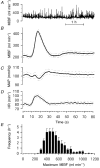
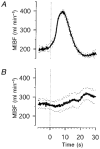

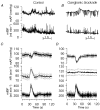
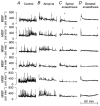
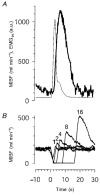


Similar articles
-
Autonomic control of skeletal muscle vasodilation during exercise.J Appl Physiol (1985). 1997 Dec;83(6):2037-42. doi: 10.1152/jappl.1997.83.6.2037. J Appl Physiol (1985). 1997. PMID: 9390978
-
Autonomic control of skeletal muscle blood flow at the onset of exercise.Am J Physiol. 1999 Nov;277(5):H1872-7. doi: 10.1152/ajpheart.1999.277.5.H1872. Am J Physiol. 1999. PMID: 10564142
-
Skeletal muscle vasodilation at the onset of exercise.J Appl Physiol (1985). 1998 Nov;85(5):1649-54. doi: 10.1152/jappl.1998.85.5.1649. J Appl Physiol (1985). 1998. PMID: 9804565
-
Neurogenic vasodilation in human skeletal muscle: possible role in contraction-induced hyperaemia.Acta Physiol Scand. 2000 Apr;168(4):481-8. doi: 10.1046/j.1365-201x.2000.00700.x. Acta Physiol Scand. 2000. PMID: 10759585 Review.
-
Vasovagal syncope and skeletal muscle vasodilatation: the continuing conundrum.Pacing Clin Electrophysiol. 1997 Mar;20(3 Pt 2):775-80. doi: 10.1111/j.1540-8159.1997.tb03903.x. Pacing Clin Electrophysiol. 1997. PMID: 9080509 Review.
Cited by
-
Have we missed that neural vasodilator mechanisms may contribute to exercise hyperemia at onset of voluntary exercise?Front Physiol. 2013 Feb 15;4:23. doi: 10.3389/fphys.2013.00023. eCollection 2013. Front Physiol. 2013. PMID: 23422870 Free PMC article.
References
-
- Bendat JS, Piersol AG. Random Data: Analysis and Measurement Procedures. New York: Wiley; 1986.
-
- Bigger JTJ, Fleiss JL, Rolnitzky LM, Steinman RC. The ability of several short-term measures of RR variability to predict mortality after myocardial infarction. Circulation. 1993;88:927–934. - PubMed
-
- Camm AJ, Malik M, Bigger JT, Breithardt G, Cerutti S, Cohen RJ, Coumel P, Fallen EL, Kennedy HL, Kleiger RE, Lombardi F, Malliani A, Moss AJ, Rottman JN, Schmidt G, Schwartz PJ, Singer DH. Heart rate variability – standards of measurement, physiological interpretation, and clinical use (Task force of the European Society of Cardiology and the North American Society of Electrophysiology) Circulation. 1996;93:1043–1065. - PubMed
-
- Caraffa-Braga E, Granata L, Pinotti O. Changes in blood flow distribution during acute emotional stress in dogs. Pflügers Archiv. 1973;339:203–316. - PubMed
Publication types
MeSH terms
Substances
LinkOut - more resources
Full Text Sources

